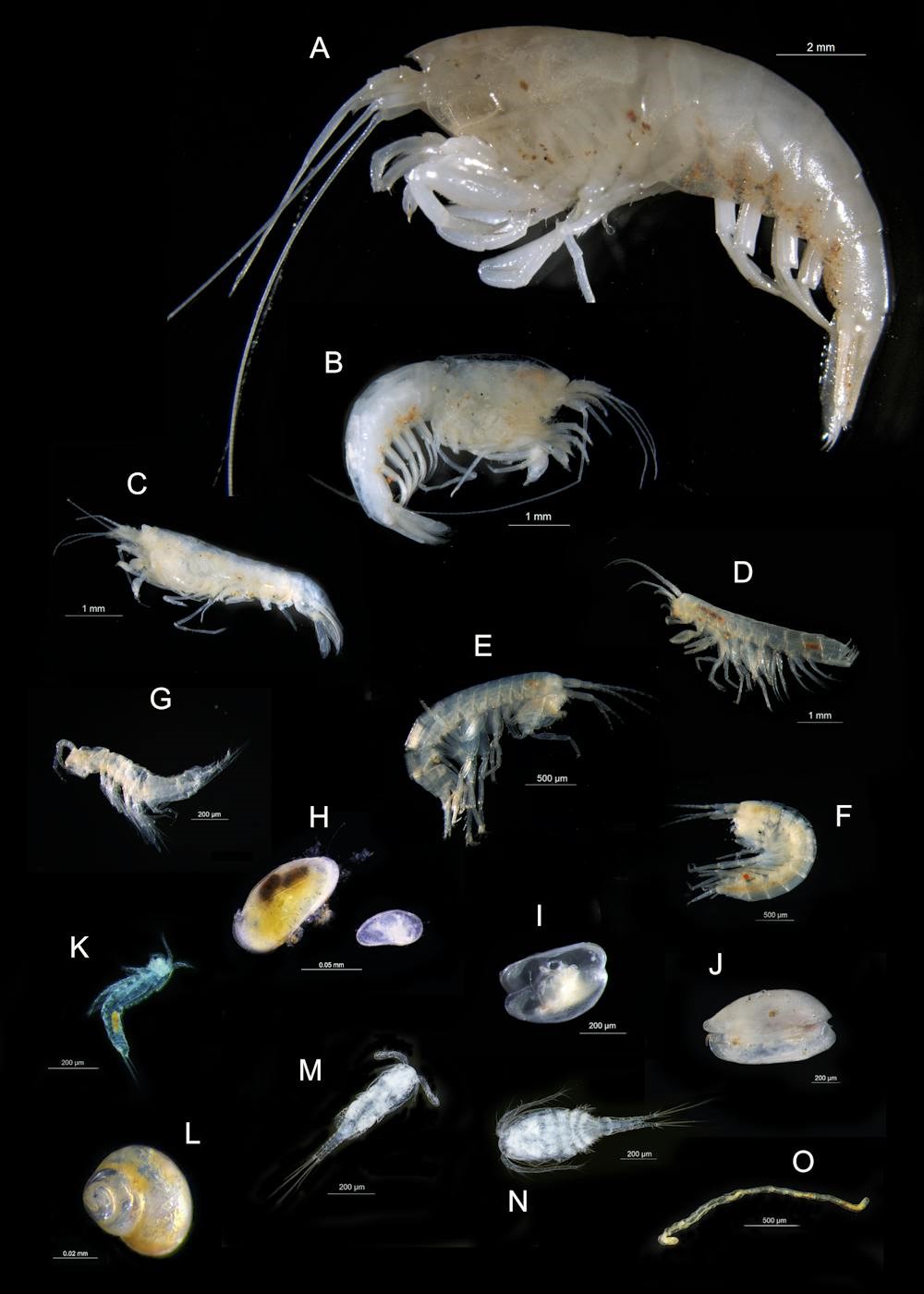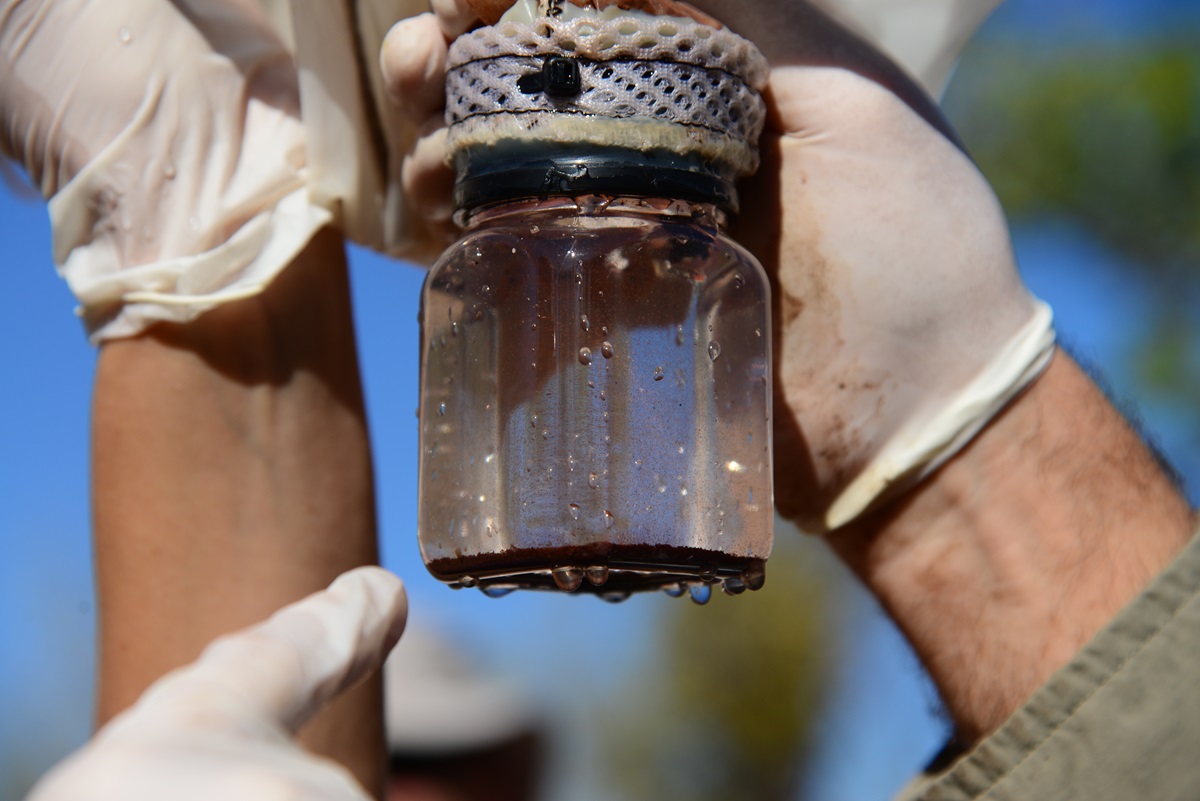Driving along the Stuart Highway from Tennant Creek to Katherine in Australia’s Northern Territory, you might be more aware of lone eagles flying high above than what lies in the groundwaters beneath.
As you cross what is the Beetaloo Sub-basin, you’re also crossing over the Cambrian Limestone Aquifer, between 50-400 metres thick and covering 570,000 square kilometres of northern Australia.
And it supports subterranean life, including stygofauna.
Stygofauna are any animals (fauna) that can be found in aquifers, subterranean caves and some surface waters.
The term originates from the word stygo which in Greek mythology refers to the River Styx that formed the boundary between the living world and the underworld.
Stygofauna are indicators of groundwater ecosystem health and play an important role in the ecology of subterranean systems including nutrient cycling. Many spend their entire lives within groundwaters, so it’s not surprising that they’ve acquired many unique biological adaptations to survive in dark, low-oxygen and nutrient-scarce environments.
There are many factors that influence the presence and species richness of stygofaunal communities, including the quality and quantity of groundwater.
CSIRO has been studying stygofaunal communities in groundwaters of the Beetaloo Sub-basin, conducted through the Gas Industry Social and Environmental Research Alliance (GISERA). The project involved sampling bores across the aquifer to build understanding of where stygofauna exist and assess their vulnerability to above-ground activities.
Dr Paul McInerney is a Senior Research Scientist with us. He says studying these communities is essential for advancing understanding of groundwater ecology, the health of aquatic ecosystems and the impacts of human activities on water resources in unique environments like the Beetaloo Sub-basin.
“Stygofauna are fascinating creatures specifically adapted to life in underground aquatic habitats,” he says.
“Often dwelling in darkness, many have lost their eyes and have developed a range of unique features to thrive in these challenging environments, which are frequently low in nutrients and oxygen.”
Studying stygofauna in the Beetaloo Sub-basin
Stygofauna are divided into three main groups:
- Stygoxenic, which accidently occur in groundwater systems
- Stygophiles, which occur both in surface and ground waters
- Stygobitic species, which occur exclusively in groundwater.
It’s this last grouping – Stygobitic species – that has been the focus of study in the Beetaloo by our aquatic ecologists.
The purpose of the study has been to define the environmental drivers of stygofauna distribution; understand the ecology of stygofaunal communities; and provide baseline data to help determine future potential impacts of industrial activity in the region.
Our researchers measured water quality and nutrients in more than 50 groundwater bores across hundreds of square kilometres of the Beetaloo Sub-basin.
Organisms, including stygofauna, were detected from environmental DNA (eDNA) extracted from groundwater samples. Stygofauna were also collected in nets, and DNA from specimens provided information on gene flow between populations at different locations.
In addition, researchers collected video footage of stygofauna swimming in groundwater bores and in the limestone cavities they intersect.
The groundwater environment of the Cambrian Limestone Aquifer was found to range from fresh to saline and, as expected, the dissolved oxygen levels were very low.
Dissolved organic carbon (which in surface waters, is usually leached from plant litter) was also low, which suggests that it is not the primary source of fuel for the stygofauna food web.
When examining the vertical distribution of stygofauna through the aquifer, researchers found they mainly occurred in cavities. These geomorphic features were found to be the biggest indicator of stygofauna presence.
Delving deep into stygofauna taxonomy
Seven distinct stygofauna taxonomic groups that live only in groundwater were identified from net samples. The community was dominated by members of the subphylum Crustacea. The largest and most common of these were shrimp that belong to the genus Parisia.
Although shrimp (Parisia spp.) were the most common animal found in bores, other smaller creatures were also detected. Researchers found Syncarids, Cyclopoids, Harpactacoids and an isopod belonging to the family Microparasellidae.

Researchers also used eDNA to sample microbes living in groundwater bores. Microbial communities differed between bores, influenced by the timing of collection, groundwater flows, aquifer connectiveness and geochemical properties. These microbes might be important for sustaining stygofauna in ecosystems that are nutrient and carbon poor.
Image Gallery
No images found.
The underground food web
On the Earth’s surface plants use energy from sunlight to take carbon dioxide out of the air and produce food for animals. But in subterranean habitats, there is no light. One group of microbes, chemolithoautotrophic bacteria, use chemical reactions and non-organic substances such as rock to obtain their energy.
Chemolithoautotrophs are important for many biogeochemical processes – including nitrification, methane oxidation, sulfate reduction, and anaerobic ammonium oxidation – that help regulate the cycling of key elements such as nitrogen, carbon, and sulfur. These microbes play a particularly vital role in environments where organic matter is scarce or oxygen is limited.
The role of chemolithoautotrophs in Beetaloo subterranean habitats is supported by previous CSIRO research in the Northern Territory.
In subterranean habitats, chemolithoautotrophs are essential for ecosystem functioning. They act as a source of carbon and energy for stygofauna – the animals that inhabit groundwater systems – by deriving energy through the oxidation of inorganic molecules.
Remarkably, these microorganisms can occur at depths of up to 100 metres below the surface, supporting life in ecosystems far removed from sunlight or surface-based nutrient inputs.
As different types of sampling and methods of analysis each have their limitations, using multiple methods, repeating sampling over time and targeting key features provide the best results.
The collection of DNA for analysis is an area of active research and methods are expected to improve with further use in different aquatic environments.

©
Potential impacts
“Because stygofauna inhabit unseen underground ecosystems, their ecological roles are often overlooked. That’s why a deeper understanding of their interactions and dependencies is crucial,” Paul says.
“These creatures contribute to vital processes like water purification and nutrient cycling within aquifers, which directly impact the quality and availability of our groundwater resources.”
To better protect stygofauna, it is essential to deepen our understanding of their ecology. These groundwater-dwelling communities are sensitive to a range of human activities, many of which can have significant and lasting impacts on their habitat. Actions such as lowering water tables, introducing nutrients or pesticides, and causing chemical contamination can disrupt the delicate balance of subterranean ecosystems.
Such disturbances may alter the physical characteristics of these habitats – including changes to water quality and the nutrient profile – which in turn can affect the microbial communities that stygofauna rely on.
These shifts can lead to changes in the biotic composition of groundwater ecosystems, ultimately reducing the diversity and abundance of stygofauna and threatening the overall health of these hidden but vital ecological networks.
By focusing future research on understanding the habitat requirements and ecology of stygofauna, we can gain a more robust understanding of the risks to their communities.
Credits
-
Author
Melina Gillespie and Paul Cunningham
-
Production editor
-
Editor
Thea Williams
-
Developer
Kate Cochrane
-
Video and photography
